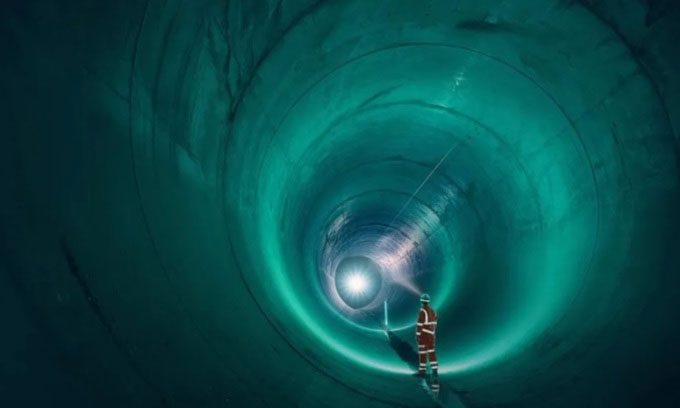After 8 years of construction, the super sewer capable of holding the equivalent of 600 Olympic swimming pools beneath London has been completed and is set to undergo trial operations this summer.
Named the Thames Tideway Tunnel, this project is designed to reduce the volume of raw sewage flowing into the River Thames. The 25km long tunnel will redirect 34 of the most polluted wastewater streams into the Thames, BBC reported on March 27. According to Andy Mitchell, CEO of the Thames Tideway project, they aim to retain the vast majority of sewage that currently flows into the river, making the Thames cleaner.

The sewer pipe is wide enough to accommodate three buses side by side. (Image: Thames Tideway Tunnel).
In the final construction phase, a massive 1,200-ton concrete cap was placed over the tunnel in eastern London. London’s combined sewer system handles both human waste and rainwater, but the city’s population has overloaded the infrastructure. Under normal conditions, raw sewage would flow into treatment plants, but even a light drizzle in London can overwhelm the system, resulting in floodwaters flowing into the River Thames. Instead of entering the river, the new super sewer will retain nearly all of the overflow sewage from central London until it can be treated.
Initially, the first flow of wastewater is expected to enter the tunnel this summer. The project will be fully operational by 2025. While the original estimated cost was $5.3 billion, the tunnel has incurred costs of approximately $6.3 billion. This expense will be borne by Thames Water customers over the coming decades.
The tunnel, which is 7.2 meters wide, gradually slopes from Acton in west London to Abbey Mills in the east. During prolonged rain periods, the tunnel will hold a mixture of raw sewage and rainwater. The facility can contain a volume of liquid equivalent to 600 Olympic swimming pools, which will then be pumped to the largest wastewater treatment plant in Europe at Beckton, east London. After operating trials throughout the summer, the super sewer will be handed over to Thames Water.
Although the new super sewer is one of the largest upgrades to London’s sewer network since it was constructed by Joseph Bazalgette in the 1860s, it is certainly not a permanent solution. Scientists predict that climate change will bring more heavy rains to the UK, meaning that there will come a time when even the gigantic super sewer will be full.
Activist Theo Thomas from the organization London Waterkeeper believes that authorities should invest in projects across London to prevent rainwater from flowing directly into the sewer system and mixing with raw sewage. Mitchell agrees with this perspective but notes that quickly building a new network to separate sewage and rainwater in London at a reasonable cost is not feasible.


















































